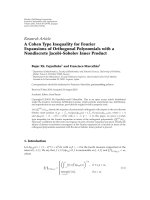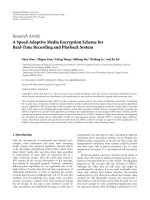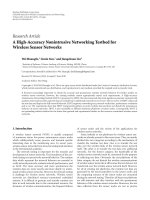Báo cáo hóa học: " Research Article A Kirk Type Characterization of Completeness for Partial Metric Spaces" docx
Bạn đang xem bản rút gọn của tài liệu. Xem và tải ngay bản đầy đủ của tài liệu tại đây (464.35 KB, 6 trang )
Hindawi Publishing Corporation
Fixed Point Theory and Applications
Volume 2010, Article ID 493298, 6 pages
doi:10.1155/2010/493298
Research Article
A Kirk Type Characterization of Completeness for
Partial Metric Spaces
Salvador Romaguera
Insitituto Universitario de Matem
´
atica Pura y Aplicada, Universidad Polit
´
ecnica de Valencia,
46071 Valencia, Spain
Correspondence should be addressed to Salvador Romaguera,
Received 1 October 2009; Accepted 25 November 2009
Academic Editor: Mohamed A. Khamsi
Copyright q 2010 Salvador Romaguera. This is an open access article distributed under the
Creative Commons Attribution License, which permits unrestricted use, distribution, and
reproduction in any medium, provided the original work is properly cited.
We extend the celebrated result of W. A. Kirk that a metric space X is complete if and only if every
Caristi self-mapping for X has a fixed point, to partial metric spaces.
1. Introduction and Preliminaries
Caristi proved in 1 that if f is a selfmapping of a complete metric space X, d such that
there is a lower semicontinuous function φ : X → 0, ∞ satisfying
d
x, fx
≤ φ
x
− φ
fx
1.1
for all x ∈ X, then f has a fixed point.
This classical result suggests the following notion. A selfmapping f of a metric space
X, d for which there is a function φ : X → 0, ∞ satisfying the conditions of Caristi’s
theorem is called a Caristi mapping for X, d.
There exists an extensive and well-known literature on Caristi’s fixed point theorem
and related results see, e.g., 2–10,etc..
In particular, Kirk proved in 7 that a metric space X, d is complete if and only
if every Caristi mapping for X, d has a fixed point. For other characterizations of metric
completeness in terms of fixed point theory see 11–14
,etc.,andalso15, 16 for recent
contributions in this direction.
In this paper we extend Kirk’s characterization to a kind of complete partial metric
spaces.
2 Fixed Point Theory and Applications
Let us recall that partial metric spaces were introduced by Matthews in 17 as a part
of the study of denotational semantics of dataflow networks. In fact, it is widely recognized
that partial metric spaces play an important role in constructing models in the theory of
computation see 18–25,etc..
A partial metric 17 on a set X is a function p : X × X → 0, ∞ such that for all
x, y, z ∈ X: i x y ⇔ px, xpx, ypy, y; ii px, x ≤ px, y; iii px, ypy,x;
iv px, z ≤ px, ypy,z
− py,y.
A partial metric space is a pair X, p where p is a partial metric on X.
Each partial metric p on X induces a T
0
topology τ
p
on X which has as a base the family
of open balls {B
p
x, ε : x ∈ X, ε > 0}, where B
p
x, ε{y ∈ X : px, y <px, xε} for all
x ∈ X and ε>0.
Next we give some pertinent concepts and facts on completeness for partial metric
spaces.
If p is a partial metric on X, then the function p
s
: X × X → 0, ∞ given by p
s
x, y
2px, y − px, x − py, y is a metric on X.
A sequence x
n
n∈N
in a partial metric space X, p is called a Cauchy sequence if there
exists andisfinite lim
n,m
px
n
,x
m
17, Definition 5.2.
Note that x
n
n∈N
is a Cauchy sequence in X, p if and only if it is a Cauchy sequence
in the metric space X, p
s
see, e.g., 17, page 194.
A partial metric space X, p is said to be complete if every Cauchy sequence x
n
n∈N
in X converges, with respect to τ
p
, to a point x ∈ X such that px, xlim
n,m
px
n
,x
m
17,
Definition 5.3.
It is well known and easy to see that a partial metric space X, p is complete if and
only if the metric space X, p
s
is complete.
In order to give an appropriate notion of a Caristi mapping in the framework of partial
metric spaces, we naturally propose the following two alternatives.
i A selfmapping f of a partial metric space X, p is called a p-Caristi mapping on X
if there is a function φ : X → 0, ∞ which is lower semicontinuous for X, p and
satisfies px, fx ≤ φx − φfx, for all x ∈ X.
ii A selfmapping f of a partial metric space X, p is called a p
s
-Caristi mapping on X
if there is a function φ : X → 0, ∞ which is lower semicontinuous for X, p
s
and
satisfies px, fx ≤ φx − φfx, for all x ∈ X.
It is clear that every p-Caristi mapping is p
s
-Caristi but the converse is not true, in
general.
In a first attempt to generalize Kirk’s characterization of metric completeness to the
partial metric framework, one can conjecture that a partial metric space X, p is complete if
and only if every p-Caristi mapping on X has a fixed point.
The following easy example shows that this conjecture is false.
Example 1.1. On the set N of natural numbers construct the partial metric p given by
p
n, m
max
1
n
,
1
m
. 1.2
Note that N,p is not complete, because the metric p
s
induces the discrete topology
on N,andn
n∈N
is a Cauchy sequence in N,p
s
. However, there is no p-Caristi mappings on
N as we show in the next.
Fixed Point Theory and Applications 3
Indeed, let f : N → N and suppose that there is a lower semicontinuous function φ
from N,τ
p
into 0, ∞ such that pn, fn ≤ φn − φfn for all n ∈ N. If 1 <f1, we have
p1,f11 p1, 1, which means that f1 ∈ B
p
1,ε for any ε>0, so φ1 ≤ φf1 by
lower semicontinuity of φ, which contradicts condition p1,f1 ≤ φ1 − φf1. Therefore
1 f1, which again contradicts condition p1,f1 ≤ φ1 − φf1. We conclude that f is not
a p-Caristi mapping on N.
Unfortunately, the existence of fixed point for each p
s
-Caristi mapping on a partial
metric space X, p neither characterizes completeness of X, p as follows from our
discussion in the next section.
2. The Main Result
In this section we characterize those partial metric spaces for which every p
s
-Caristi mapping
has a fixed point in the style of Kirk’s characterization of metric completeness. This will be
done by means of the notion of a 0-complete partial metric space which is introduced as
follows.
Definition 2.1. A sequence x
n
n∈N
in a partial metric space X, p is called 0-Cauchy if
lim
n,m
px
n
,x
m
0. We say that X, p is 0-complete if every 0-Cauchy sequence in X
converges, with respect to τ
p
, to a point x ∈ X such that px, x0.
Note that every 0-Cauchy sequence in X, p is Cauchy in X, p
s
, and that every
complete partial metric space is 0-complete.
On the other hand, the partial metric space Q ∩ 0, ∞,p, where Q denotes the set
of rational numbers and the partial metric p is given by px, ymax{x, y}, provides a
paradigmatic example of a 0-complete partial metric space which is not complete.
In the proof of the “only if” part of our main result we will use ideas from 11, 26,
whereas the following auxiliary result will be used in the proof of the “if” part.
Lemma 2.2. Let X, p be a partial metric space. Then, for each x ∈ X, the function p
x
: X → 0, ∞
given by p
x
ypx, y is lower semicontinuous for X, p
s
.
Proof. Assume that lim
n
p
s
y, y
n
0, then
p
x
y
≤ p
x
y
n
p
y
n
,y
− p
y
n
,y
n
p
x
y
n
p
s
y
n
,y
− p
y
n
,y
p
y, y
. 2.1
This yields lim inf
n
p
x
y
n
≥ p
x
y because py,y ≤ py,y
n
.
Theorem 2.3. A partial metric space X, p is 0-complete if and only if every p
s
-Caristi mapping f
on X has a fixed point.
Proof. Suppose that X, p is 0-complete and let f be a p
s
-Caristi mapping on X, then, there is
a φ : X → 0, ∞ which is lower semicontinuous function for X, p
s
and satisfies
p
x, fx
≤ φ
x
− φ
fx
, 2.2
for all x ∈ X.
4 Fixed Point Theory and Applications
Now, for each x ∈ X define
A
x
:
y ∈ X : p
x, y
≤ φ
x
− φ
y
. 2.3
Observe that A
x
/
φ because fx ∈ A
x
. Moreover A
x
is closed in the metric space X, p
s
since
y → px, yφy is lower semicontinuous for X, p
s
.
Fix x
0
∈ X. Take x
1
∈ A
x
0
such that φx
1
< inf
y∈A
x
0
φy2
−1
. Clearly A
x
1
⊆ A
x
0
.
Hence, for each x ∈ A
x
1
we have
p
x
1
,x
≤ φ
x
1
− φ
x
< inf
y∈A
x
0
φ
y
2
−1
− φ
x
≤ φ
x
2
−1
− φ
x
2
−1
.
2.4
Following this process we construct a sequence x
n
n∈ω
in X such that its associated sequence
A
x
n
n∈ω
of closed subsets in X, p
s
satisfies
i A
x
n1
⊆ A
x
n
,x
n1
∈ A
x
n
for all n ∈ ω,
ii px
n
,x < 2
−n
for all x ∈ A
x
n
,n∈ N.
Since px
n
,x
n
≤ px
n
,x
n1
, and, by i and ii, px
n
,x
m
< 2
−n
for all m>n,it follows
that lim
n,m
px
n
,x
m
0, so x
n
n∈ω
is a 0-Cauchy sequence in X, p, and by our hypothesis,
there exists z ∈ X such that lim
n
pz, x
n
pz, z0, and thus lim
n
p
s
z, x
n
0. Therefore
z ∈
n∈ω
A
x
n
.
Finally, we show that z fz.To this end, we first note that
p
x
n
,fz
≤ p
x
n
,z
p
z, fz
≤ φ
x
n
− φ
z
φ
z
− φ
fz
,
2.5
for all n ∈ ω. Consequently fz ∈
n∈ω
A
x
n
, so by ii, px
n
,fz < 2
−n
for all n ∈ N. Since
pz, fz ≤ pz, x
n
px
n
,fz, and lim
n
pz, x
n
0, it follows that pz, fz0. Hence
p
s
z, fz0sincep
s
z, fz ≤ 2pz, fz, so z fz.
Conversely, suppose that there is a 0-Cauchy sequence x
n
n∈ω
of distinct points in
X, p which is not convergent in X, p
s
. Construct a subsequence y
n
n∈ω
of x
n
n∈ω
such
that py
n
,y
n1
< 2
−n1
for all n ∈ ω.
Put A {y
n
: n ∈ ω}, and define f : X → X by fx y
0
if x ∈ X \ A, and fy
n
y
n1
for all n ∈ ω.
Observe that A is closed in X, p
s
.
Now define φ : X → 0, ∞ by φxpx, y
0
1ifx ∈ X \ A, and φy
n
2
−n
for all
n ∈ ω.
Note that φy
n1
<φy
n
for all n ∈ ω and that φy
0
≤ φx for all x ∈ X \ A.
From this fact and the preceding lemma we deduce that φ is lower semicontinuous for
X, p
s
.
Moreover, for each x ∈ X \ A we have
p
x, fx
p
x, y
0
φ
x
− φ
y
0
φ
x
− φ
fx
, 2.6
Fixed Point Theory and Applications 5
and for each y
n
∈ A we have
p
y
n
,fy
n
p
y
n
,y
n1
< 2
−n1
φ
y
n
− φ
y
n1
φ
y
n
− φ
fy
n
.
2.7
Therefore f is a Caristi p
s
-mapping on X without fixed point, a contradiction. This
concludes the proof.
Acknowledgments
The author is very grateful to the referee for his/her useful suggestions. This work was
partially supported by the Spanish Ministry of Science and Innovation, and FEDER, Grant
MTM2009-12872-C02-01.
References
1 J. Caristi, “Fixed point theorems for mappings satisfying inwardness conditions,” Transactions of the
American Mathematical Society, vol. 215, pp. 241–251, 1976.
2 I. Beg and M. Abbas, “Random fixed point theorems for Caristi type random operators,” Journal of
Applied Mathematics & Computing, vol. 25, no. 1-2, pp. 425–434, 2007.
3 D. Downing and W. A. Kirk, “A generalization of Caristi’s theorem with applications to nonlinear
mapping theory,” Pacific Journal of Mathematics, vol. 69, no. 2, pp. 339–346, 1977.
4 Y. Feng and S. Liu, “Fixed point theorems for multi-valued contractive mappings and multi-valued
Caristi type mappings,” Journal of Mathematical Analysis and Applications, vol. 317, no. 1, pp. 103–112,
2006.
5 J. R. Jachymski, “Caristi’s fixed point theorem and selections of set-valued contractions,” Journal of
Mathematical Analysis and Applications, vol. 227, no. 1, pp. 55–67, 1998.
6 M. A. Khamsi, “Remarks on Caristi’s fixed point theorem,” Nonlinear Analysis: Theory, Methods &
Applications, vol. 71, no. 1-2, pp. 227–231, 2009.
7 W. A. Kirk, “Caristi’s fixed point theorem and metric convexity,” Colloquium Mathematicum, vol. 36,
no. 1, pp. 81–86, 1976.
8 A. Latif, “Generalized Caristi’s fixed point theorems,” Fixed Point Theory and Applications, vol. 2009,
Article ID 170140, 7 pages, 2009.
9 W. A. Kirk and J. Caristi, “Mappings theorems in metric and Banach spaces,” Bulletin de l’Acad
´
emie
Polonaise des Sciences. S
´
erie des Sciences Math
´
ematiques, Astronomiques et Physiques, vol. 23, no. 8, pp.
891–894, 1975.
10 T. Suzuki, “Generalized Caristi’s fixed point theorems by Bae and others,” Journal of Mathematical
Analysis and Applications, vol. 302, no. 2, pp. 502–508, 2005.
11 S. Park, “Characterizations of metric completeness,” Colloquium Mathematicum, vol. 49, no. 1, pp. 21–
26, 1984.
12 S. Reich, “Kannan’s fixed point theorem,” Bollettino dell’Unione Matematica Italiana, vol. 4, pp. 1–11,
1971.
13 P. V. Subrahmanyam, “Completeness and fixed-points,” Monatshefte f
¨
ur Mathematik, vol. 80, no. 4, pp.
325–330, 1975.
14 T. Suzuki and W. Takahashi, “Fixed point theorems and characterizations of metric completeness,”
Topological Methods in Nonlinear Analysis, vol. 8, no. 2, pp. 371–382, 1996.
15 S. Dhompongsa and H. Yingtaweesittikul, “Fixed points for multivalued mappings and the metric
completeness,” Fixed Point Theory and Applications, vol. 2009, Article ID 972395, 15 pages, 2009.
16 T. Suzuki, “A generalized Banach contraction principle that characterizes metric completeness,”
Proceedings of the American Mathematical Society, vol. 136, no. 5, pp. 1861–1869, 2008.
6 Fixed Point Theory and Applications
17 S. G. Matthews, “Partial metric topology,” in Proceedings of the 8th Summer Conference on General
Topology and Applications (Flushing, NY, 1992), vol. 728 of Annals of the New York Academy of Sciences,
pp. 183–197, The New York Academy of Sciences, New York, NY, USA, 1994.
18 R. Heckmann, “Approximation of metric spaces by partial metric s paces,” Applied Categorical
Structures, vol. 7, no. 1-2, pp. 71–83, 1999.
19 S. J. O’Neill, “Partial metrics, valuations, and domain theory,” in Proceedings of the 11th Summer
Conference on General Topology and Applications (Gorham, ME, 1995), vol. 806 of Annals of the New York
Academy of Sciences, pp. 304–315, The New York Academy of Sciences, New York, NY, USA, 1996.
20 S. Romaguera and M. Schellekens, “Partial metric monoids and semivaluation spaces,” Topology and
Its Applications, vol. 153, no. 5-6, pp. 948–962, 2005.
21 S. Romaguera and O. Valero, “A quantitative computational model for complete partial metric spaces
via formal balls,” Mathematical Structures in Computer Science, vol. 19, no. 3, pp. 541–563, 2009.
22 M. Schellekens, “The Smyth completion: a common foundation for denotational semantics and
complexity analysis,” Electronic Notes in Theoretical Computer Science, vol. 1, pp. 535–556, 1995.
23 M. P. Schellekens, “A characterization of partial metrizability: domains are quantifiable,” Theoretical
Computer Science, vol. 305, no. 1–3, pp. 409–432, 2003.
24 P. Waszkiewicz, “Quantitative continuous domains,” Applied Categorical Structures, vol. 11, no. 1, pp.
41–67, 2003.
25 P. Waszkiewicz, “Partial metrisability of continuous posets,” Mathematical Structures in Computer
Science, vol. 16, no. 2, pp. 359–372, 2006.
26 J P. Penot, “Fixed point theorems without convexity,” Bulletin de la Soci
´
et
´
eMath
´
ematique de France,no.
60, pp. 129–152, 1979.









